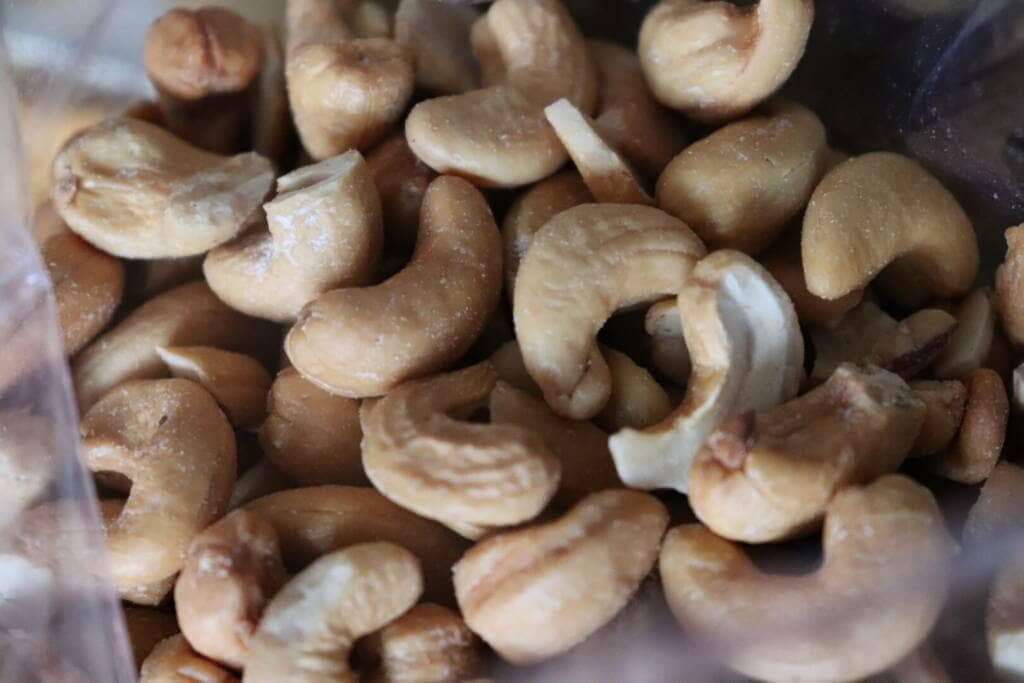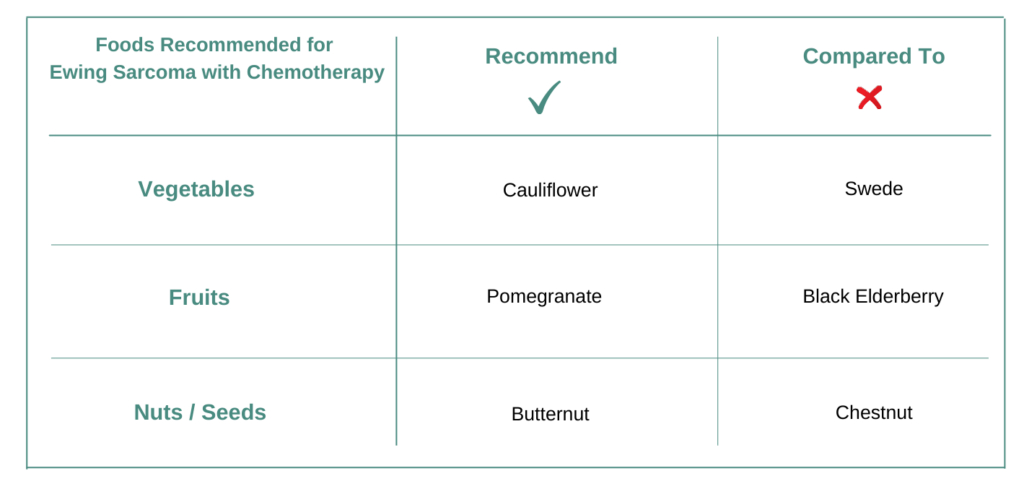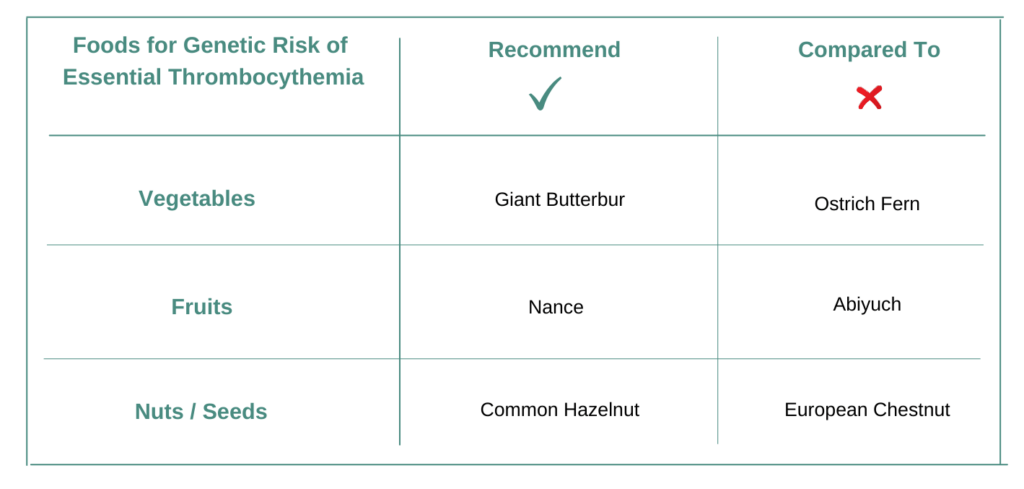Introduction
Foods for Ewing Sarcoma should be personalized for each individual and also must adapt when cancer treatment or tumor genetic change. The personalization and adaptation must consider all the active ingredients or bioactives contained in different foods with respect to cancer tissue biology, genetics, treatments, lifestyle conditions and diet preferences. Hence while nutrition is one of the very important decisions for a cancer patient and individual at risk of cancer to make – how to choose foods to eat is not an easy task.
Ewing sarcoma is a rare form of bone cancer that primarily affects children and young adults. It is often compared to osteosarcoma due to similarities in bone involvement. Symptoms of Ewing sarcoma may include bone pain, swelling in tissue around the bones, fever, broken bones without an injury, fatigue and unexpected weight loss. Ewing sarcoma is typically caused by a translocation involving chromosomes 11 and 22. In rare cases, Ewing sarcoma may metastasize to the lungs, contributing to lung cancer. About 30% of patients with Ewing sarcoma will have a recurrence within the first five years of diagnosis. Treatment involves a multimodal approach, including chemotherapy, surgery, and radiation therapy, however, there is no standard therapy for relapsed and refractory Ewing sarcoma with survival rates being less than 30% in those with isolated lung metastases and less than 20% in those with bone and bone marrow involvement. Although Ewing sarcoma is more commonly seen in children and young adults, it can rarely occur in adults as well. The survival rate for Ewing sarcoma has improved over the years, thanks to advancements in treatment options; with a 5-year survival rate for localized and regional tumors being around 70-80%. Prognosis varies depending on factors such as the stage and response to therapy.
For Ewing Sarcoma does it matter what vegetables, fruits, nuts, seeds one eats?
A very common nutrition question asked by cancer patients and individuals at-genetic risk of cancer is – for cancers like Ewing Sarcoma does it matter what foods I eat and which I do not? Or if I follow a plant-based diet is that enough for cancer like Ewing Sarcoma?
For example does it matter if vegetable Cauliflower is consumed more compared to Swede? Does it make any difference if fruit Black Elderberry is preferred over Pomegranate? Also if similar choices are made for nuts/seeds like Butternut over Chestnut and for pulses like Alfalfa over Hyacinth Bean. And if what I eat matters – then how does one identify foods which are recommended for Ewing Sarcoma and is it the same answer for everyone with the same diagnosis or genetic risk?
Yes! Foods you eat matters for Ewing Sarcoma!
Food recommendations may not be the same for everyone and can be different even for the same diagnosis and genetic risk.

All foods (vegetables, fruits, nuts, seeds, pulses, oils etc.) and nutritional supplements are made up of more than one active molecular ingredient or bio-actives in different proportions and quantities. Each active ingredient has a unique mechanism of action – which can be activation or inhibition of different biochemical pathways. Simply stated foods and supplements which are recommended are those which do not cause an increase of molecular drivers of cancer but reduce them. Else those foods should not be recommended. Foods contain multiple active ingredients – hence when evaluating foods and supplements you need to consider the impact of all active ingredients cumulatively rather than individually.
For example Black Elderberry contains active ingredients Apigenin, Lycopene, Curcumin, Lupeol, Quercetin. And Pomegranate contains active ingredients Apigenin, Ellagic Acid, Curcumin, Lupeol, Quercetin and possibly others.
A common mistake made when deciding and choosing foods to eat for Ewing Sarcoma – is to evaluate only selected active ingredients contained in foods and ignore the rest. Because different active ingredients contained in foods may have opposing effects on cancer drivers – you cannot cherry pick active ingredients in foods and supplements for making a nutrition decision for Ewing Sarcoma.
YES – FOOD CHOICES MATTER FOR CANCER. NUTRITION DECISIONS MUST CONSIDER ALL ACTIVE INGREDIENTS OF FOODS.
Skills Needed for Nutrition Personalization for Ewing Sarcoma?
Personalized nutrition for cancers like Ewing Sarcoma consists of recommended foods / supplements; not recommended foods / supplements with example recipes which prioritize use of recommended foods. An example of personalized nutrition can be seen at this link.
Deciding which foods are recommended or not is extremely complicated, requiring expertise in Ewing Sarcoma biology, food science, genetics, biochemistry along with good understanding of how cancer treatments work and associated vulnerabilities by which the treatments could stop being effective.
MINIMUM KNOWLEDGE EXPERTISE NEEDED FOR NUTRITION PERSONALIZATION FOR CANCER ARE: CANCER BIOLOGY, FOOD SCIENCE, CANCER TREATMENTS AND GENETICS.
Foods to Eat After Cancer Diagnosis!
No two cancers are the same. Go beyond the common nutrition guidelines for everyone and make personalized decisions about food and supplements with confidence.
Characteristics of cancers like Ewing Sarcoma
All cancers like Ewing Sarcoma can be characterized by a unique set of biochemical pathways – the signature pathways of Ewing Sarcoma. Biochemical pathways like Cell Cycle, Cytoskeletal Dynamics, PI3K-AKT-MTOR Signaling, Cell Cycle Checkpoints are part of the signature definition of Ewing Sarcoma. Each individual’s cancer genetics can be different and hence their specific cancer signature could be unique.
The treatments which are effective for Ewing Sarcoma need to be cognizant of the associated signature biochemical pathways for each cancer patient and individual at genetic risk. Therefore different treatments with different mechanisms of actions are effective for different patients. Similarly and for the same reasons foods and supplements need to be personalized for each individual. Hence some foods and supplements are recommended for Ewing Sarcoma when taking cancer treatment Vincristine, and some foods and supplements are not recommended.
Sources like cBioPortal and many others provide population representative patient anonymized data from clinical trials for all cancer indications. This data consists of clinical trial study details like sample size / number of patients, age groups, gender, ethnicity, treatments, tumor site and any genetic mutations.
STAG2, TP53, RYR2, EZH2 and HSD3B2 are the top ranked reported genes for Ewing Sarcoma. STAG2 is reported in 10.5 % of the representative patients across all clinical trials. And TP53 is reported in 4.7 %. The combined population patient data cover ages from 1 to 79. 56.2 % of the patient data are identified as men. The Ewing Sarcoma biology along with reported genetics together define the population represented signature biochemical pathways for this cancer. If the individual cancer tumor genetics or genes contributing to the risk are also known then that should also be used for nutrition personalization.
NUTRITION CHOICES SHOULD MATCH WITH EACH INDIVIDUAL’S CANCER SIGNATURE.
Food and Supplements for Ewing Sarcoma
For Cancer Patients
Cancer patients on treatment or on palliative care need to make decisions on food and supplements – for the needed dietary calories, for managing any treatment side effects and also for improved cancer management. All plant-based foods are not equal and choosing and prioritizing foods which are personalized and customized to ongoing cancer treatment is important and complicated. Here are some examples providing guidelines for making nutrition decisions.
Choose Vegetable CAULIFLOWER or SWEDE?
Vegetable Cauliflower contains many active ingredients or bioactives such as Curcumin, Lupeol, Phloretin, Daidzein, Beta-sitosterol. These active ingredients manipulate various biochemical pathways like MAPK Signaling, Carbohydrate Metabolism, NFKB Signaling and PI3K-AKT-MTOR Signaling and others. Cauliflower is recommended for Ewing Sarcoma when ongoing cancer treatment is Vincristine. This is because Cauliflower modifies those biochemical pathways which have been scientifically reported to sensitize the effect of Vincristine.
Some of the active ingredients or bioactives in vegetable Swede are Apigenin, Curcumin, Lupeol, Phloretin, Daidzein. These active ingredients manipulate various biochemical pathways like Cytoskeletal Dynamics, Epithelial to Mesenchymal Transition and PI3K-AKT-MTOR Signaling and others. Swede is not recommended for Ewing Sarcoma when ongoing cancer treatment is Vincristine because it modifies those biochemical pathways which make the cancer treatment resistant or less responsive.
VEGETABLE CAULIFLOWER IS RECOMMENDED OVER SWEDE FOR Ewing Sarcoma AND TREATMENT Vincristine.
Choose Fruit POMEGRANATE or BLACK ELDERBERRY?
Fruit Pomegranate contains many active ingredients or bioactives such as Apigenin, Ellagic Acid, Curcumin, Lupeol, Quercetin. These active ingredients manipulate various biochemical pathways like MAPK Signaling, Carbohydrate Metabolism, NFKB Signaling and PI3K-AKT-MTOR Signaling and others. Pomegranate is recommended for Ewing Sarcoma when ongoing cancer treatment is Vincristine. This is because Pomegranate modifies those biochemical pathways which have been scientifically reported to sensitize the effect of Vincristine.
Some of the active ingredients or bioactives in fruit Black Elderberry are Apigenin, Lycopene, Curcumin, Lupeol, Quercetin. These active ingredients manipulate various biochemical pathways like Cytoskeletal Dynamics, Epithelial to Mesenchymal Transition and PI3K-AKT-MTOR Signaling and others. Black Elderberry is not recommended for Ewing Sarcoma when ongoing cancer treatment is Vincristine because it modifies those biochemical pathways which make the cancer treatment resistant or less responsive.
FRUIT POMEGRANATE IS RECOMMENDED OVER BLACK ELDERBERRY FOR Ewing Sarcoma AND TREATMENT Vincristine.
Choose Nut BUTTERNUT or CHESTNUT?
Butternut contains many active ingredients or bioactives such as Apigenin, Lycopene, Curcumin, Lupeol, Myricetin. These active ingredients manipulate various biochemical pathways like MAPK Signaling, RAS-RAF Signaling, NFKB Signaling and PI3K-AKT-MTOR Signaling and others. Butternut is recommended for Ewing Sarcoma when ongoing cancer treatment is Vincristine. This is because Butternut modifies those biochemical pathways which have been scientifically reported to sensitize the effect of Vincristine.
Some of the active ingredients or bioactives in Chestnut are Apigenin, Ellagic Acid, Lycopene, Curcumin, Lupeol. These active ingredients manipulate various biochemical pathways like WNT Beta Catenin Signaling, Cytoskeletal Dynamics and Epithelial to Mesenchymal Transition and others. Chestnut is not recommended for Ewing Sarcoma when ongoing cancer treatment is Vincristine because it modifies those biochemical pathways which make the cancer treatment resistant or less responsive.
BUTTERNUT IS RECOMMENDED OVER CHESTNUT FOR Ewing Sarcoma AND TREATMENT Vincristine.

For Individuals with Genetic Risk of Cancer
The question asked by individuals who have genetic risk of Ewing Sarcoma or familial history is “What Should I Eat Differently from Before?” and how they should choose foods and supplements to manage risks of the disease. Since for cancer risk there is nothing actionable in terms of treatment – decisions of foods and supplements become important and one of the very few actionable things which can be done. All plant-based foods are not equal and based on identified genetics and pathway signature – the choices of food and supplements should be personalized.
Choose Vegetable GIANT BUTTERBUR or OSTRICH FERN?
Vegetable Giant Butterbur contains many active ingredients or bioactives such as Curcumin, Apigenin, Lupeol, Daidzein, Formononetin. These active ingredients manipulate various biochemical pathways like MAPK Signaling, DNA Repair, PI3K-AKT-MTOR Signaling and Oxidative Stress and others. Giant Butterbur is recommended for risk of Ewing Sarcoma when associated genetic risk is EZH2. This is because Giant Butterbur increases those biochemical pathways which counteract the signature drivers of it.
Some of the active ingredients or bioactives in vegetable Ostrich Fern are Curcumin, Apigenin, Lupeol, Daidzein, Formononetin. These active ingredients manipulate various biochemical pathways like Oxidative Stress and others. Ostrich Fern is not recommended when risk of Ewing Sarcoma when associated genetic risk is EZH2 because it increases the signature pathways of it.
VEGETABLE GIANT BUTTERBUR IS RECOMMENDED OVER OSTRICH FERN FOR EZH2 GENETIC RISK OF CANCER.
Choose Fruit NANCE or ABIYUCH?
Fruit Nance contains many active ingredients or bioactives such as Curcumin, Apigenin, Lupeol, Daidzein, Formononetin. These active ingredients manipulate various biochemical pathways like MAPK Signaling, DNA Repair, PI3K-AKT-MTOR Signaling and Oxidative Stress and others. Nance is recommended for risk of Ewing Sarcoma when associated genetic risk is EZH2. This is because Nance increases those biochemical pathways which counteract the signature drivers of it.
Some of the active ingredients or bioactives in fruit Abiyuch are Curcumin, Apigenin, Lupeol, Daidzein, Formononetin. These active ingredients manipulate various biochemical pathways like Oxidative Stress and others. Abiyuch is not recommended when risk of Ewing Sarcoma when associated genetic risk is EZH2 because it increases the signature pathways of it.
FRUIT NANCE IS RECOMMENDED OVER ABIYUCH FOR EZH2 GENETIC RISK OF CANCER.
Choose Nut COMMON HAZELNUT or EUROPEAN CHESTNUT?
Common Hazelnut contains many active ingredients or bioactives such as Curcumin, Lupeol, Quercetin, Daidzein, Formononetin. These active ingredients manipulate various biochemical pathways like MAPK Signaling, DNA Repair, Noncoding RNA Signaling and PI3K-AKT-MTOR Signaling and others. Common Hazelnut is recommended for risk of Ewing Sarcoma when associated genetic risk is EZH2. This is because Common Hazelnut increases those biochemical pathways which counteract the signature drivers of it.
Some of the active ingredients or bioactives in European Chestnut are Curcumin, Apigenin, Ellagic Acid, Lupeol, Quercetin. These active ingredients manipulate various biochemical pathways like Oxidative Stress and others. European Chestnut is not recommended when risk of Ewing Sarcoma when associated genetic risk is EZH2 because it increases the signature pathways of it.
COMMON HAZELNUT IS RECOMMENDED OVER EUROPEAN CHESTNUT FOR EZH2 GENETIC RISK OF CANCER.

In Conclusion
Foods and Supplements chosen are important decisions for cancers like Ewing Sarcoma. Ewing Sarcoma patients and individuals with genetic-risk always have this question: “What foods and nutritional supplements are recommended for me and which are not?” There is a common belief which is a misconception that all plant-based foods could be beneficial or not but would not be harmful. Certain foods and supplements can interfere with cancer treatments or promote molecular pathway drivers of cancer.
There are different types of cancer indications like Ewing Sarcoma, each with different tumor genetics with further genomic variations across each individual. Further every cancer treatment and chemotherapy has a unique mechanism of action. Each food like Cauliflower contains various bioactives in different quantities, which have an impact on different and distinct sets of biochemical pathways. The definition of personalized nutrition is individualized food recommendations for the cancer indication, treatments, genetics, lifestyle and other factors. Nutrition personalization decisions for cancer require knowledge of cancer biology, food science and an understanding of different chemotherapy treatments. Finally when there are treatment changes or new genomics is identified – the nutrition personalization needs re-evaluation.
The addon nutrition personalization solution makes the decision making easy and removes all the guesswork in answering the question, “What foods should I choose or not choose for Ewing Sarcoma?”. The addon multi-disciplinary team includes cancer physicians, clinical scientists, software engineers and data scientists.
Personalized Nutrition for Cancer!
Cancer changes with time. Customize and modify your nutrition based on cancer indication, treatments, lifestyle, food preferences, allergies and other factors.
References
- Pan Origimed 2020
- Cancer therapy shapes the fitness landscape of clonal hematopoiesis.
- Research progress on the anticancer effects of vitamin K2.
- Gallic acid inhibits gastric cancer cells metastasis and invasive growth via increased expression of RhoB, downregulation of AKT/small GTPase signals and inhibition of NF-κB activity.
- Brassinin Represses Invasive Potential of Lung Carcinoma Cells through Deactivation of PI3K/Akt/mTOR Signaling Cascade.
- Lycopene differentially induces quiescence and apoptosis in androgen-responsive and -independent prostate cancer cell lines.
- Paederia foetida induces anticancer activity by modulating chromatin modification enzymes and altering pro-inflammatory cytokine gene expression in human prostate cancer cells.
- https://www.ncbi.nlm.nih.gov/books/NBK559183
- https://my.clevelandclinic.org/health/diseases/21752-ewings-sarcoma
- https://www.hopkinsmedicine.org/health/conditions-and-diseases/sarcoma/ewing-sarcoma-in-adults#:~:text=What%20is%20the%20long%2Dterm,15%20percent%20to%2030%20percent.
- https://www.ncbi.nlm.nih.gov/books/NBK559183
